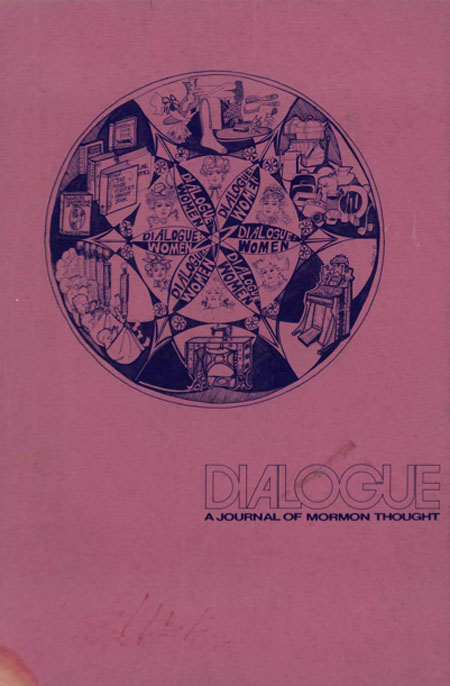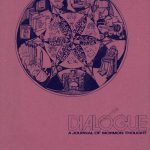Blog
Topic pages: Feminism
July 3, 2021
Podcast:
Dialogue Topics Pages Podcast: Feminism
Issues and Articles:
2010: Laurel Thatcher Ulrich, “Mormon Women in the History of Second-Wave Feminism” Dialogue 43.2 (Fall 2010) 45 – 63.
Reading these books in relation to my own life taught me something I should already have known. Mormon women weren’t passive recipients of the new feminism. We helped to create it.
2009: Katie Clark Blakesly, “‘A Style of Our Own’: Mormon Women and Modesty,” Dialogue 42.2 (Summer 2009) 21 – 56.
Clothing has been the subject of scriptural injunctions and aperennial topic of Church leaders’ concern. Subtle changes inboth dress standards and rationales for modest dress in the latterhalf of the twentieth century reflect the LDS Church’s teachingsand attitudes toward chastity and women, the feminine ideal, andchanging women’s roles.
2003: Laurel Thatcher Ulrich, “Border Crossings,” Dialogue 27.2: 1 – 7.
It happened again as I was walking through the New Hampshire woods with a woman I knew only slightly. We had been chatting amiably when the words “Mormon feminist” escaped my mouth. From the expression on her face, I knew exactly what she was going to say. “Mormon feminist! That sounds like an oxymoron!”
2003: Carol Lynn Pearson, “’Dear Brethren’—Claiming a Voice in the Church,” Dialogue 36.3 (Fall 2003): 201 – 206.
Carol Lynn Pearson explains ways she has claimed a voice and encouraged others to do so.
1995: Cecilia Konchar Farr, “Dancing Through the Doctrine,” Dialogue 28.3 (1995): 1 – 12.
As American feminist thinkers and organizers, we’ve walked a long road since then, a road that has led us farther and farther away from religious discourse and Christian justification. Our reasons have been good: We didn’t want to limit or exclude. We didn’t want to direct all feminists down a single philosophical path.
1994: Lynn Matthews Anderson, “Toward a Feminist Interpretation of Latter-day Saint Scripture ,” Dialogue 27.2 (1994): 185 – 203.
During the past five years I have read the Book of Mormon more than a hundred times both while working on The Easy-to-Read Book of Mormon and later. In retrospect, I am astonished that it took so many readings and a focus on the question of using gender-inclusive language in the simplified version to discover something that should have been obvious to me from the beginning: females scarcely figure or matter in our sacred books.
1988: Lavina Fielding Anderson, “A Voice from the Past: The Benson Instructions for Parents,” Dialogue 21.4 (Winter 1988): 103 – 13.
I must admit that the immediate reaction to the “Mothers” speech — largely negative in my immediate circle — caught me off guard. I was meeting with a group of women on the night that it was broadcast, and my husband, Paul, thoughtfully recorded it for me. I listened to it the next day, mentally observed that the speech had a decidedly old-fashioned ring to it, and used the tape to record 3-2-1 Contact for our son, Christian. I was immediately sorry
1985: Linda Wilcox, “Crying Change in a Permanent World,” Dialogue 18.2 (Summer 1985): 116 – 127.
Women in the Mormon Church are encouraged toward traditional roles and attitudes that discourage personal, familial, and societal change. The ideal female role is that of a non-wage-earning wife and mother in a nuclear family where the husband is the provider and the woman’s energies are directed toward her family, the Church, and perhaps community service.
1985: Melodie Moench Charles, “LDS Women and Priesthood: Scriptural Precedents for Priesthood,” Dialogue 18.3 (Fall 1985): 15 – 20.
I have heard many LDS women approach the issue of women and the priesthood by protesting that they do not want to hold the priesthood because they have no interest in passing the sacrament or performing some other ecclesiastical duty. I will venture a guess that many men who have the priesthood do not particularly want to hold it either, and that some of them also have no interest in passing the sacrament. But the reluctance of some men would hardly be a good reason to prevent all men from holding the priesthood.
1985: Linda King Newell, “The Historical Relationship of Mormon Women and Priesthood,” Dialogue 18.3 (Fall 1985): 21 – 32.
While an examination of that history leaves unanswered the question of women’s ordination to the priesthood, the historical overview of LDS women’s relationship to priesthood suggests a more expansive view than many members now hold.
1985: Meg Wheatley-Pesci, “LDS Women and Priesthood: An Expanded Definition of Priesthood: Some Present and Future Consequences,” Dialogue 18.3 (Fall 1985): 35 – 42.
In seeking to predict what might occur in the Church if priesthood were extended to women, it is helpful to focus attention on some of these organizational dynamics.
1978: Dixie Snow Huefner, “Church and Politics at the Utah IWY Conference,” Dialogue 11.1 (1978): 58 – 76.
During the spring of 1977, Utah’s two major newspapers began their coverage of what was to become one of the hottest political controversies of the year: the Utah Women’s Conference authorized by the National Commission on the Observance of International Women’s Year and scheduled for June 24-25
1971: Pink issue, especially Claudia’s introduction
While to all outward appearances we had nothing to complain of, the first meeting was an impassioned exchange of frustrations, disappointments and confessions. We had expected some serious confrontations because all attending are not in complete agreement on various issues, and there were some. More notable, though, were the shared feelings and mutual support that emerged.
And if you have suggestions for other Dialogue topic pages, please email here.


 Back to all blog articles
Back to all blog articles


